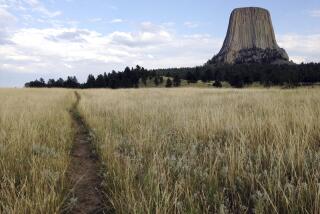Almost Homeless: ‘Mad Housing’ in Atlanta : Their volunteer-built shacks are in hidden spots but hut-dwellers fear they are living on borrowed time.
Huts may not be houses, but scores of Atlantans call them home.
For three years now, a group of socially conscious architects, industrial designers and others, called “the Mad Housers,” has been building shacks for homeless people. They have erected 87 of the little structures in out-of-the-way places around town--near railroad tracks, under viaducts. Made of plywood and measuring 6 feet by 8 feet, the huts are just big enough to hold a cot and a few personal possessions.
At one time the little emergency shelters, which have no running water or electricity, do not comply with building codes and are considered eyesores by many, drew the wrath of city and state officials. During high-profile events, such as the 1988 Democratic National Convention, some of them were evacuated. Some have been razed.
Lately, a kinder and gentler era has taken hold. Nevertheless, some of the hut-dwellers are worried that they will be moved. They live under the Martin Luther King Jr. Drive viaduct near downtown and next to the construction site of the Georgia Dome. The $210-million, 70,500-seat facility is scheduled for completion in 1992 and Atlanta recently won the right to host the 1994 Super Bowl there.
The sports news brought great joy to official Atlanta, and visions of the Olympics and the NBA All-Stars danced in Mayor Maynard Jackson’s head. “This is just the beginning,” he declared. “We’re going to stage the greatest Super Bowl ever.”
But there was no joy under the viaduct. There was no sadness, either. Only cynicism and resolve, the two constant companions of the homeless and nearly homeless people who drop out or fall out of society and then live lives of repeated displacement. Here, as in other cities, the people on the bottom of the socioeconomic ladder often disparage urban revitalization even when they are promised that it will help them.
“We know that, eventually, we will have to move,” said Roger, who has lived under the viaduct six months. Turning to a visitor, he sneered. He said: “I have a $10 house next to a $210-million stadium. They don’t want me next to them. You don’t want me next to you.”
Several of Roger’s neighbors, who had gathered in front of the neighborhood row of huts to chat and play bid whist, shouted their agreement. They talked passionately and proudly about how they help to guard the surrounding property, about how they live as day laborers and scrap collectors and how they shun official shelters because they are crowded and dangerous.
Boasting about how the comrades look out for each other, one man challenged the visitor, saying: “I leave my hut with the door unlocked. I bet you can’t leave your hut without locking your door.”
Local officials insist that it is too soon to worry about losing the huts.
“The city has not expressed any plan of action on that,” said Jerome Eppinger of the Atlanta Office of Human Services, who coordinates assistance to the homeless. “We let them know about other facilities. Beyond that, you have to let people make their own choice. This is their shelter of choice.”
Jody Plummer, a nurse with a community health program, was skeptical. “I wouldn’t be surprised if they were moved,” she said. “It would be really sad if the city takes them away and doesn’t put anything in their place.”
Michael Connor, an architect who is a Mad Houser, believes the “moneywigs” will be driven to dismantle the huts “for appearances’ sake.”
He added: “Society is insensitive, or there wouldn’t be such a problem with homelessness.” An estimated 8,000 homeless people live in this city of 420,000.
Under the viaduct, a resolute young man was certain that his hut would be destroyed, but he was philosophical.
“When they move us,” he said, “we just become more tenacious. We’re like roaches. We survive.”
More to Read
Sign up for Essential California
The most important California stories and recommendations in your inbox every morning.
You may occasionally receive promotional content from the Los Angeles Times.










